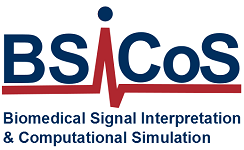-
Projects
Multimodal analysis and m-Health tools for diagnostic and monitoring improving of Obstructive Lung Disease and Obstructive Sleep Apnea patients (M-LODOSA)
Start date
2016
End date
2018
Coordinator
Raimon Jané
IP BSICoS: Pablo Laguna
Funding agency
CIBER – ISCIII
Pediatric sleep apnea-hypopnea syndrome (SAHS) affects up to 5% of children population and is associated with major cardiovascular illnesses. Its high prevalence, the relative unavailability of proper facilities, as well as the complexity, time-consuming, and costs inherent to the standard diagnostic test (polysomnography, PSG) suggest the search for simpler and more affordable alternatives. In this project, we propose the development of a pediatric SAHS screening tool based on the overnight heart rate variability signal (HRV). It focuses on a twofold purpose. On the one hand, it is intended for the screening of the most severely affected children, that is, those that make use of facilities and consume time of the specialist but are less challenging in their diagnosis. On the other hand, our tool also targets the identification of those children at risk of suffering from cardiovascular issues associated with SAHS, such as hypertension, hypercholesterolemia, or high levels of insulin, glucose, or triglycerides. Both complementary approaches would ease the labor of sleep specialists and alleviate the stress of the frequently overwhelmed facilities while quickening the diagnosis and treatment of those children at high health risk.
In this project, we provide prior results of our approach, which were retrospectively validated offline using algorithms implemented with scientific tools. Thus, we start from a Technology Readiness Level (TRL) 3. Our purpose is reaching TRL 5 by implementing our solution in a real clinical environment and using a commercial software architecture. The Sleep Unit of the Hospital Universitario Rio Hortega in Valladolid (Spain) will be involved, as its responsible, Dr. Félix del Campo, is member of the CIBER-BBN group CB19/01/00012. The Target Product Profile (TPP) has been designed to mimic the diagnostic results showed in our previous investigations while accounting for the specificities of the clinical services.
A successful development of the project would lead to a new pediatric SAHS diagnostic screening tool with ability to detect cardiac risks in the affected children too. This not only would have a positive impact in both the health and quality of life of patients, but also would be a market opportunity in public and private healthcare systems, as well as in companies acting in the area of healthcare technologies. Accordingly, we present a strategy for industrial property protection and commercialization of results that include the communication of results to our usual collaborating organizations, algorithm patent (USA) and registering of intellectual property (Spain and European Union), and their licensing to third parties for their commercial exploitation. Finally, those major results not subject to industrial property protection will be disseminated in high impact journals under the Open Access standard, as well as in the main bioengineering and medical conferences.
